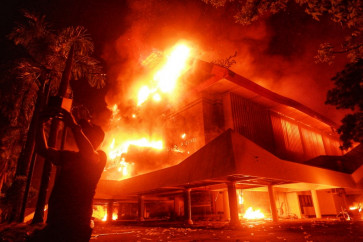Popular Reads
Top Results
Can't find what you're looking for?
View all search resultsPopular Reads
Top Results
Can't find what you're looking for?
View all search resultsCaterpillar outbreak: Another black swan?
A caterpillar outbreak has recently spread across 15 districts in Java, Bali, East Lombok, Bekasi (West Java) and lastly in West Jakarta
Change text size
Gift Premium Articles
to Anyone
A
caterpillar outbreak has recently spread across 15 districts in Java, Bali, East Lombok, Bekasi (West Java) and lastly in West Jakarta. Thousands and thousands of caterpillars, with their stingy hairs, unconsciously terrorize the residents of areas they invade.
This issue becomes interesting when people attribute this phenomenon to the presence of humans. Some traditional people say it is a punishment or warning from God, just like the plague of frogs in Moses’ time, while a more modern person might attribute it to climate change that has been accelerated by human activities during recent decades.
The former opinion is not the concern of this article because it is related to faith — which cannot be studied extensively here. So I will focus on the latter, which is the subject of science.
Rod Eastwood, an entomologist from Harvard University, said that attributing the cause of the outbreak to climate change could be hard to prove, despite the fact that climate change can lead to unseasonal weather — which can disturb plant growth and the life cycle of host plants.
Thus, plants may provide more or less food at critical times in caterpillars’ development cycle. In addition, this condition is also unsuitable for the natural enemies of the caterpillar such as parasitoids or fungi, so caterpillars can develop well without disturbance.
However, unpredictable explosions of insect populations have often been seen throughout history. In Wisconsin, US, the first recorded outbreak was in 1600 and since then outbreaks have occurred at irregular intervals. There was also an outbreak of Bogong moths in Australia, Baicalina caddis flies on Lake Baikal. Such phenomena could be influenced by a combination of several factors.
In 1995, research was conducted on the climate and an outbreak of forest tent caterpillars in North America. The study, conducted by the University of British Columbia, found that weather variables did not influence the population dynamics of forest tent caterpillars. This fact is interesting since it implies that climate change is not the only factor responsible for caterpillar outbreaks. Instead, such outbreaks can also be regarded as a natural phenomenon.
Also, if climate change is the only factor causing this phenomenon, why has it only happened in random locations in Bali, East Lombok, West Java and a small part of Jakarta?
Why did the outbreaks not happen in Kalimantan or Sumatra? As regions located nearer to the equator, these islands are undergoing the same impacts of climate change and we may expect the same phenomenon to happen there. But apparently it hasn’t. Instead, the phenomenon has only happened in a random style affecting southern Indonesia.
The first outbreak was in Probolinggo, East Java, and then it moved to the western part of the island, to Jombang, and Kendal in Central Java, and then to Bekasi in West Java, but then it moved backward to Bali, jumped to East Lombok and now has been reported in Jakarta.
Interestingly, different regions were invaded by different species of caterpillars. Probolinggo was invaded by Lymantria atemeles and Arctornis sp, Banyuwangi was invaded by Dasychira inclusa, and certainly different species invaded other areas.
It is suspected that most of them are from the Lymantriidae family, which includes the Tussock Moth that is covered in irritating hairs during its larval stage.
Our local scientist, Supata, from Gajah Mada University, says no one is sure what triggers such massive outbreaks. As explained above, several circumstances influence the phenomenon. But I think this phenomenon is an example of a “Black Swan” event, a term that was developed by economist and philosopher Nassim Taleb.
Yes, it is a black swan. It is something highly unpredictable (a surprise) and after its first recording, people tend to rationalize it. It is a natural phenomenon and will disappear naturally without a massive burning or excessive spraying of insecticide. Those efforts will only create another ecological imbalance.
The writer is a science journalist.










